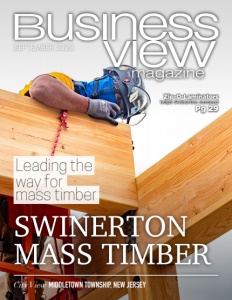The Kalesnikoff Lumber Company
High quality lumber products
Business View Magazine interviews Chris Kalesnikoff, of the Kalesnikoff Lumber Co., as part of our focus on mass timber production operations in North America.
The Kalesnikoff Lumber Company is located in Thrums, British Columbia, on the banks of the Kootenay River, in a region rich in forest resources and scenic beauty. There, this family-owned and operated company produces some of the highest-quality softwood lumber products in the world in a variety of species, strengths, textures, densities, and grain patterns, while also earning an international reputation for sustainable forest stewardship and a balanced approach to environmental, social, and economic values.
“Our business was started in 1939 by my great grandfather and his two brothers,” recounts company COO, Chris Kalesnikoff, who, along with his sister, CFO Krystle Seed, are the fourth-generation of Kalesnikoffs to run the company, alongside their father and CEO Ken Kalesnikoff. “They were of Russian descent and settled in Canada in the late 1890s, made their way across the west, and, eventually, settled here in British Columbia. During the Great Depression, the family had the opportunity to harvest firewood for some local refineries and saw an opportunity to turn that into a mountainside operation. The family would travel up on Sunday by horseback, build a camp, horse-log all week, and then come out into the village on Saturday with product. That’s how the business started. My grandfather got involved in the business at a young age, and by 20, became the general manager. He was a strong entrepreneur and saw the opportunity to grow the business from a small mountainside logging operation into a full-fledged sawmill operation. By the late 1960s, we relocated and started our new sawmill facility, which then included complete log breakdowns, planer mills, dry kilns, and so on.”
“My father came on board at a young age, as well, with the same kind of entrepreneurial bloodlines,” Chris continues. “The roots of our business have always been value-added; we’ve always looked at ways to best utilize the product to get the most value out of it, and we’ve always been able to look for niche markets, globally. So, in the late 1990s, we started our second facility, which was a re-manufacturing plant. That plant focused on value-added products. We starting do more things outside of just lumber and timbers. Eventually, that plant produced lineal products, such as softwood paneling, flooring, exterior wood siding, moldings, and trims, etc. My sister and I also started with the company at a young age; we both went away to school and returned in the early 2000s, and being fourth generation, we had the same goals: to continue to grow our business with the same values that the generations before us brought forth.”
Today, Kalesnikoff Lumber has over 160 employees and two different branches – its solid timber division, which is focused on global markets: North America, Europe, Australia, New Zealand, and most particularly, Japan; and its mass timber division, which deals with large construction firms in North America and is focused on producing finished buildings, including single- and multi-family homes, and large commercial structures. “We started looking into mass timber fairly aggressively in 2014, and it’s been a six-year journey,” says Chris. “Our mass timber facility came online earlier this year, so now, we have parallel marketplaces. We’re not only looking for solid lumber/timber construction, but now, we’re actually supplying finished projects and buildings, as well.”
In fact, Kalesnikoff’s new, $35-million, state-of-the-art mass timber facility promises to make the company the most advanced, vertically integrated, multi-species mass timber manufacturer in North America, offering Cross Laminated Timber (CLT), Glue Laminated Timber (GLT) panels, and Glulam Beams and Columns.
CLT is formed by stacking and gluing together multi-layers of dimensional lumber at an alternating 90 degree orientation. These layered stacks are then pressed both vertically and horizontally to allow for an exceptionally clean (edge-glued) panel, which can be precision-sized and finished to be installation-ready for a jobsite. When used for timber construction, GLT combines traditional mass timber construction techniques with the precision and quality of engineered wood products. The result is a stronger, lighter weight structural material that also offers a cleaner, more attractive aesthetic. Glulam Beams and Columns are made from lamstock-grade, dimensional lumber that is bonded together with strong, waterproof adhesive. Glulam can be manufactured into a large variety of different shapes and sizes for innovative applications where strength, durability, and design are important.
 While mass timber construction has been utilized in Europe for the past few decades, it has only lately been recognized in North America by architects, engineers, designers, and developers who are increasingly seeking high-quality, custom mass timber products to create sustainable, safe, and energy-efficient structures. “CLT, specifically, in mass timber is something that has been proven in Europe for 20-plus years and it’s been pioneered in North America since 2010,” Chris reports. “And now, ten years later, there’s been enough projects out there that people are starting to understand how to utilize the product; there’s more supply available; and there’s just more experience, in general, in the market. There’s more understanding on the structural engineering side and there’s more desire on the architectural side to utilize wood. So, it’s adding more belief and comfort with the developers. We’re seeing a lot of successful projects being completed where speed of construction has been proven and installation savings have been recognized. And all those things, coming together, continue to help the market grow, and we’re starting to see some really rapid growth, now.”
While mass timber construction has been utilized in Europe for the past few decades, it has only lately been recognized in North America by architects, engineers, designers, and developers who are increasingly seeking high-quality, custom mass timber products to create sustainable, safe, and energy-efficient structures. “CLT, specifically, in mass timber is something that has been proven in Europe for 20-plus years and it’s been pioneered in North America since 2010,” Chris reports. “And now, ten years later, there’s been enough projects out there that people are starting to understand how to utilize the product; there’s more supply available; and there’s just more experience, in general, in the market. There’s more understanding on the structural engineering side and there’s more desire on the architectural side to utilize wood. So, it’s adding more belief and comfort with the developers. We’re seeing a lot of successful projects being completed where speed of construction has been proven and installation savings have been recognized. And all those things, coming together, continue to help the market grow, and we’re starting to see some really rapid growth, now.”
In addition to its new mass timber facility, Chris points out several other characteristics that he feels give Kalesnikoff Lumber an edge over its competitors. “One of the great things for us is the area in which we live,” he states. “We have some of the world’s best timber supply – it’s strong; it’s beautiful. So, when you start with a natural resource with that type of value, it’s a natural competitive advantage. Then, there’s the fact that we remain family-owned and operated. Our family has been in this area for 81 years. We have some very strong core values in how we run our business and we’re relationship and quality-based. Those things go a long way and have allowed us to be successful, globally.”
One of the company’s key core values lies in its understanding that timber is, in some ways, a fragile, yet, ultimately, renewable resource. While the company gets some of its wood from the stands owned by the provincial government, as well as other private landowners, Kalesnikoff has its own supply to handle and harvest. “Our Woodlands team is very extensive and we put a lot of time and effort into managing the land base for the utmost sustainability,” Chris explains. “We’re doing a lot of LIDAR modeling, so we have a strong understanding of the topography of the land.” (LIDAR, which stands for Light Detection and Ranging, is a remote sensing method that uses light in the form of a pulsed laser to examine the surface of the Earth. These light pulses—combined with other data recorded by the airborne system — generate precise, three-dimensional information about the shape of the Earth and its surface characteristics.)
As part of our forest management, we replant three seedlings for every one mature tree that we harvest. We work to understand future climate patterns to ensure our replanted seedlings have a long healthy life cycle and are better suited for future obstacles such as drought patterns or insect infestations. We have over 10 different species in our area and each species, at different elevations, is going to have different levels of success. We try to use forward forecasting to understand what the future climates and droughts will look like and we try to plant species that will be successful in those types of environments. So, there’s quite a bit of science and forecasting that comes into play when we’re deciding what and where to replant.”
Two other challenges in the lumber business are fire and insects. “Wildfires have been a significant issue in British Columbia,” Chris notes. We’ve began proactively working on fire mitigation strategies in our local communities and operating areas to help reduce the risk and damage potential if a future wildfire was to occur. Regarding insects, he remarks: “We’re fairly fortunate where we live; we’re just north of the U.S. border and over 500kms inland from the coast; we have beautiful mountain ranges that offer diverse elevations, with of the peaks reaching up to 8,000 feet. We enjoy nice cool winters and warm summers. That allows for a very diverse forestland. This diversity of tree species help protect us against some of the beetle issues that have been a serious problem throughout the province. For instance, the pine beetle cannot travel as quickly or cause as significant damage because the density of pine is far less compared to other regions. We still remain very proactive in managing our forestlands. If we find small outbreaks of mountain pine beetle, or Douglas fir beetle, we’re quick to react and we tend to go harvest those areas to ensure that we’re mitigating those bugs from being able to reproduce and travel.”
Long-term, Chris says, in conclusion: “We want to continue to bring as much value as we can to the beautiful resource that we have and we believe that mass timber is a great fit for the future of our business. We’re very passionate about sustainability of timber and about recognizing the value of the tree. We’re very active, now, throughout Canada and the United States; we’re working on projects coast to coast and we feel that we can be a leader in mass timber construction. We are confident our integrated model will bring a beautiful product to the marketplace at a very competitive price, and our desire is to help grow mass timber across North America. As 4th generation, I am proud to carry on our tradition of 81 years in business and grateful to continue to operate in our local community as a successful family-owned operation.
AT A GLANCE
WHO: The Kalesnikoff Lumber Company
WHAT: A family-owned lumber products company
WHERE: Castlegar, British Columbia
WEBSITE: www.kalesnikoff.com
PREFERRED VENDORS
Hexion Inc. – www.hexion.com
Hexion has been enabling the forest products industry for more than 80 years with its resins and adhesives. Not only do manufacturers see improved benefits in production, but the forest products industry continues to see gains in sustainability – something we should all be proud of.







